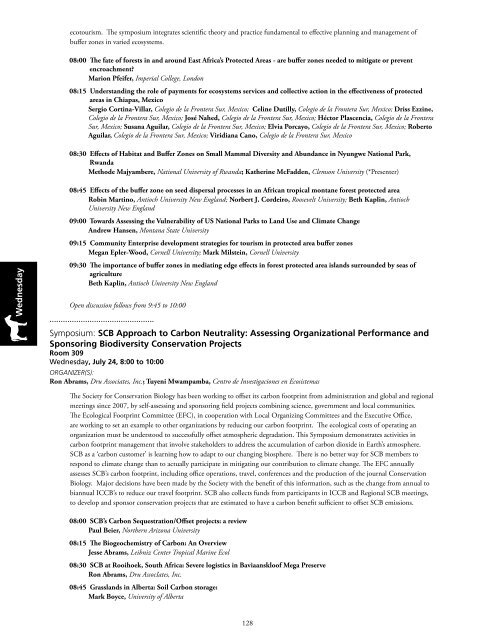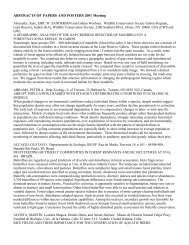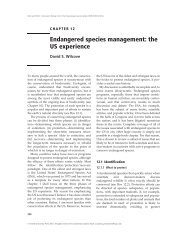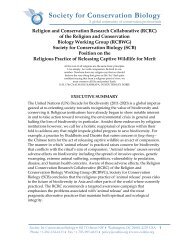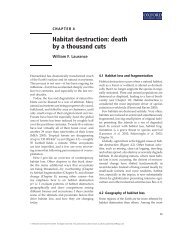ICCB 2013 Program - Society for Conservation Biology
ICCB 2013 Program - Society for Conservation Biology
ICCB 2013 Program - Society for Conservation Biology
You also want an ePaper? Increase the reach of your titles
YUMPU automatically turns print PDFs into web optimized ePapers that Google loves.
ecotourism. The symposium integrates scientific theory and practice fundamental to effective planning and management of<br />
buffer zones in varied ecosystems.<br />
08:00 The fate of <strong>for</strong>ests in and around East Africa’s Protected Areas - are buffer zones needed to mitigate or prevent<br />
encroachment<br />
Marion Pfeifer, Imperial College, London<br />
08:15 Understanding the role of payments <strong>for</strong> ecosystems services and collective action in the effectiveness of protected<br />
areas in Chiapas, Mexico<br />
Sergio Cortina-Villar, Colegio de la Frontera Sur, Mexico; Celine Dutilly, Colegio de la Frontera Sur, Mexico; Driss Ezzine,<br />
Colegio de la Frontera Sur, Mexico; José Nahed, Colegio de la Frontera Sur, Mexico; Héctor Plascencia, Colegio de la Frontera<br />
Sur, Mexico; Susana Aguilar, Colegio de la Frontera Sur, Mexico; Elvia Porcayo, Colegio de la Frontera Sur, Mexico; Roberto<br />
Aguilar, Colegio de la Frontera Sur, Mexico; Viridiana Cano, Colegio de la Frontera Sur, Mexico<br />
08:30 Effects of Habitat and Buffer Zones on Small Mammal Diversity and Abundance in Nyungwe National Park,<br />
Rwanda<br />
Methode Majyambere, National University of Rwanda; Katherine McFadden, Clemson University (*Presenter)<br />
Wednesday<br />
08:45 Effects of the buffer zone on seed dispersal processes in an African tropical montane <strong>for</strong>est protected area<br />
Robin Martino, Antioch University New England; Norbert J. Cordeiro, Roosevelt University; Beth Kaplin, Antioch<br />
University New England<br />
09:00 Towards Assessing the Vulnerability of US National Parks to Land Use and Climate Change<br />
Andrew Hansen, Montana State University<br />
09:15 Community Enterprise development strategies <strong>for</strong> tourism in protected area buffer zones<br />
Megan Epler-Wood, Cornell University; Mark Milstein, Cornell University<br />
09:30 The importance of buffer zones in mediating edge effects in <strong>for</strong>est protected area islands surrounded by seas of<br />
agriculture<br />
Beth Kaplin, Antioch University New England<br />
Open discussion follows from 9:45 to 10:00<br />
...............................................<br />
Symposium: SCB Approach to Carbon Neutrality: Assessing Organizational Per<strong>for</strong>mance and<br />
Sponsoring Biodiversity <strong>Conservation</strong> Projects<br />
Room 309<br />
Wednesday, July 24, 8:00 to 10:00<br />
Organizer(s):<br />
Ron Abrams, Dru Associates, Inc.; Tuyeni Mwampamba, Centro de Investigaciones en Ecosistemas<br />
The <strong>Society</strong> <strong>for</strong> <strong>Conservation</strong> <strong>Biology</strong> has been working to offset its carbon footprint from administration and global and regional<br />
meetings since 2007, by self-assessing and sponsoring field projects combining science, government and local communities.<br />
The Ecological Footprint Committee (EFC), in cooperation with Local Organizing Committees and the Executive Office,<br />
are working to set an example to other organizations by reducing our carbon footprint. The ecological costs of operating an<br />
organization must be understood to successfully offset atmospheric degradation. This Symposium demonstrates activities in<br />
carbon footprint management that involve stakeholders to address the accumulation of carbon dioxide in Earth’s atmosphere.<br />
SCB as a ‘carbon customer’ is learning how to adapt to our changing biosphere. There is no better way <strong>for</strong> SCB members to<br />
respond to climate change than to actually participate in mitigating our contribution to climate change. The EFC annually<br />
assesses SCB’s carbon footprint, including office operations, travel, conferences and the production of the journal <strong>Conservation</strong><br />
<strong>Biology</strong>. Major decisions have been made by the <strong>Society</strong> with the benefit of this in<strong>for</strong>mation, such as the change from annual to<br />
biannual <strong>ICCB</strong>’s to reduce our travel footprint. SCB also collects funds from participants in <strong>ICCB</strong> and Regional SCB meetings,<br />
to develop and sponsor conservation projects that are estimated to have a carbon benefit sufficient to offset SCB emissions.<br />
08:00 SCB’s Carbon Sequestration/Offset projects: a review<br />
Paul Beier, Northern Arizona University<br />
08:15 The Biogeochemistry of Carbon: An Overview<br />
Jesse Abrams, Leibniz Center Tropical Marine Ecol<br />
08:30 SCB at Rooihoek, South Africa: Severe logistics in Baviaanskloof Mega Preserve<br />
Ron Abrams, Dru AssocIates, Inc.<br />
08:45 Grasslands in Alberta: Soil Carbon storage:<br />
Mark Boyce, University of Alberta<br />
128


